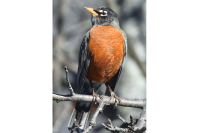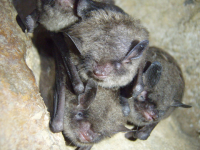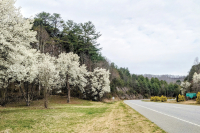Maggie ABC store captures share of Waynesville business
The recession has taken a toll on liquor sales at the ABC stores in Maggie Valley and Waynesville, in turn reducing the profits paid out to the towns.
Rather than curtailing their intake, customers are buying cheaper brands, according to Joy Rasmus, manager of the Waynesville ABC store.
“It is an easy thing to cut back on. It is a luxury item,” Rasmus said.
Meanwhile, fewer tourists during the recession hurt sales at Maggie’s main ABC store. Austin Pendley, the chairman of the Maggie ABC board, cited “the lack of full motel rooms” as the main factor behind a drop in sales.
Maggie Valley’s ABC store has noticed a further decline in business following the rockslide on I-40, which closed part of the interstate and discouraged travel.
“We could tell an immediate difference,” Pendley said.
That said, the rockslide occurred just when the tourist season was winding down anyway, making it difficult to determine what can be blamed on the rockslide versus the standard drop off Maggie sees this time of year anyway.
“There are too many variables this year,” Pendley said, adding that sales will pick up again when ski season arrives in full force.
Maggie is also bracing for a potential loss in ABC revenue with the advent of liquor at Harrah’s Cherokee Casino and Hotel. The hotel at Harrah’s began selling alcohol in restaurants and bars this fall, with hopes of eventually offering it inside the casino itself.
Maggie’s ABC store had been a favorite stop for those en route to Harrah’s.
“It will definitely have an effect. There’s no doubt about that, but to what degree I do not know,” Pendley said.
Maggie’s ABC store did a brisk business in miniature airplane bottles, which gamblers would tuck into their pockets and purses before heading over the mountain to the casino.
If and when Harrah’s begins offering alcohol to gamblers on the casino floor, Pendley expects a drop off in sales of airplane bottles.
Turf wars
In a tactical move to grow revenues, Maggie Valley opened a second ABC store this year aimed at capturing business from Waynesville. Maggie’s second store is on the outer fringes of town — more than a mile outside the town proper. Maggie annexed a satellite tract into its town limits to strategically build a new store between Maggie and Waynesville on U.S. 19 in Dellwood.
“Building store number two has been very gratifying,” Pendley said.
The second store likely pulled some business away from Maggie’s existing ABC store.
“We knew some portion would be siphoned from store number one. We don’t know how much,” Pendley said, citing the myriad variables at play this year.
Since Maggie’s new store opened, revenue at Waynesville’s ABC profits have taken a dive (see chart). While Maggie ABC revenue has grown by an additional $30,000 to $50,000 a month since the opening of the new store, Waynesville’s has dropped by a comparable amount.
The drop in revenue came as no surprise to Joy Rasmus, the manager of the Waynesville ABC store.
“We were expecting an impact, but we didn’t know how much,” Rasmus said.
Waynesville once captured a large share of the liquor purchases in the county by default. Residents from the county’s outlying areas come to Waynesville for their grocery shopping. While in the neighborhood, they would stop by the ABC store.
But Maggie’s new store — stationed practically at Waynesville’s doorstep — is snagging a share of what Waynesville once got.
It’s particularly true for those making a special trip from places like Lake Junaluska and Jonathan Creek.
“If you were just coming to town to buy alcohol, it is easier to stop at Maggie’s new store,” Rasmus said.
In response, Waynesville’s ABC Board is contemplating a new store of its own: one in the vicinity of the new Super Wal-Mart. Super Wal-Mart pulls in a huge volume of traffic, which Rasmus would like to capitalize on.
The current ABC store in Waynesville has been there since 1967.
“Absolutely we’ve outgrown it,” Rasmus said.
The Waynesville ABC Board is keeping an eye out for property to build on in the Super Wal-Mart vicinity, but there’s nothing concrete in the works yet.
“In a perfect world, it would be nice to keep two stores,” Rasmus said.
Opening a new ABC store isn’t cheap, Pendley said. There’s the cost of land and construction, but there’s also start up costs like shelving and a computer system. The upfront inventory cost to stock the store was “overwhelming,” Pendley added.
“We had no idea that there was going to be a recession or we probably wouldn’t have done it at this time, but we were too far committed not to go ahead with it,” Pendley said of the second store.
But Pendley is glad they did. The second store has already proven lucrative and will continue to pay off for the town, which reaps the profits from ABC operations.
“The whole purpose is to get more revenue to keep down taxes,” Pendley said of their mission.
Developers have plans for sites near Wal-Mart
A local developer has purchased a key parcel alongside Super Wal-Mart in Waynesville, potentially kick-starting long-awaited commercial redevelopment along the South Main Street corridor.
The coming of Super Wal-Mart was heralded as an instant recipe for growth around it. But by the time Wal-Mart opened its doors a year ago, the recession was in full swing. Not only has a South Main boom failed to materialize, but Home Depot killed plans to open a store there.
But Brian Noland, a Waynesville developer and Realtor, is drafting plans for a retail strip sporting six storefronts along South Main Street with hopes of attracting national franchises.
“I put myself in their shoes, and if I am looking to go somewhere, that is definitely a hot spot,” Noland said, citing traffic volume from Wal-Mart and the easy access off the U.S. 23-74 bypass.
Noland closed on the two-acre parcel this month for $600,000. The total project will cost several million dollars, he said. Noland hopes to have the building completed and occupied by early summer.
Mark Clasby, the Haywood County Economic Development Director, said he is glad to see movement in the area. While Waynesville has the consumer demand to support many of the national franchises Noland is likely courting, scouts often look solely at population data, Clasby said.
“But we know there are more people than that because of tourists and the second-home market. They just don’t necessarily show up,” Clasby said. “It will take some salesmanship to convince [retailers] from a demographic standpoint that ‘You need to be here.’”
Noland has a national franchise broker working to line up leases. Noland said he was “a very small fish in a big sea,” but believes if he builds it, they will come.
Meanwhile, a second so-called “outparcel” in the Super Wal-Mart complex has also sold. A 1.8-acre tract behind Hardees sold for $550,000. The developer of the site, Donald Holland, has submitted site plans to the town for a car wash and oil change business and an additional commercial building for an unidentified tenant. The site is located along the Waynesville Commons entrance drive off South Main Street.
While Noland has not yet locked in leases, he already has the project underway with the building design. The attractive architecture will sport stacked stone and stucco with varying rooflines and pronounced eaves. It’s a good thing, since a run-of-the-mill, monotonous, low-slung strip mall wouldn’t pass muster with the town’s design standards. Noland has yet to submit his plans to the town for approval, but believes the town will like the look.
The development of the Super Wal-Mart outparcels were considered key to the appearance of South Main. Town leaders hoped attractive developments fronting South Main would visually shield the sprawling Wal-Mart parking lot set further back on the site.
Noland is a Realtor with Remax Creekside Realty. He is currently developing a 46-unit affordable townhouse development in the Clyde area. His first foray into development was in the mini-storage unit business 14 years ago. He has also built and operated three car wash and lube locations in Haywood County.
“I love developing. I really do,” Noland said. “Hopefully, the whole shopping center itself will be a one-stop shop.”
Noland has had the property under contract for 10 months. He purchased it from Cedarwood Development, a national firm that developed the complex known as Waynesville Commons and leases the site to Super Wal-Mart.
Several property owners along the corridor have had their property on the market since the coming of Super Wal-Mart, even booting out current tenants in anticipation of hot demand by national chains seeking proximity to the retail giant. So far, these property owners have failed to find takers.
Best Buy and a Verizon Wireless store are the only two major retailers that have set up shop around Wal-Mart so far.
The 12-acre site immediately beside Wal-Mart that was once slated for a Home Depot does not appear to have a taker yet. Home Depot, which had already purchased the site and even designed a building before backing out, still owns the site and is actively marketing it.
“The economy has obviously had an impact on that,” Clasby said. “It’s not an easy market, there is no question about it.”
New company part of a long local legacy
The merger of Osondu Booksellers and Blue Ridge Books and Café will eventually bring under one roof the long legacy of two beloved Waynesville institutions catering to readers and etched in the memory of the downtown community
A legacy of books
Osondu Booksellers is a direct descendant of the original Waynesville Book Co., which opened on Waynesville’s Main Street in 1870. That store fell victim to the Depression. In the 1970s, Charlie and Edie Sloan opened Sloan’s Book Shop in a building just a few doors away from where Osondu is now located. They eventually moved one block off Main Street.
Kent Stewart bought Sloan’s in 1997, and in 2002 moved it back to Main Street, renaming it The Waynesville Book Company. On a visit to Waynesville in 2003, Margaret Osondu was visiting Stewart’s store and mentioned she wanted to open a bookstore of her own. He offered to sell The Waynesville Book Company, and the deal was completed in September 2004.
Curb Market memories
While Blue Ridge Books and Café is now the town’s largest seller of magazines and newspapers, that title was held by the Open Air Curb Market from 1946 until 2004.
The store, with its old wooden floors and farm paraphernalia nailed to its walls, was a general store, newsstand, and superette combined, never switching to bar codes and scanners and still carrying Nehi sodas and boiled peanuts. But it was the voluminous daily delivery of newspapers and other periodicals that brought people in every day.
When its owner Adeline Patrick died, her daughters kept it going for a couple of years before selling the building, which became High Country Style. Three years passed before Blue Ridge Books and Café opened a storefront on Main Street and filled the void of somewhere to buy magazines and papers.
Waynesville Rec Center struck by vandals
The Waynesville Recreation Center was vandalized late sometime late Monday night or early Tuesday morning.
The vandals entered the building through a broken window into the pool area. Once inside, they broke internal windows, threw furniture around, pulled clocks off the wall and otherwise wreaked havoc.
“There was glass everywhere,” said Det. Ryan Singleton, who is the lead investigator officer in the case.
They even discharged fire extinguishers.
“The whole entire building was covered in the residue from the fire distinguishers,” Singleton said.
In the kitchen area, vandals emptied the contents of cupboards onto the floor, including food coloring, flour and vinegar. Profanity was spray-painted on the kitchen walls as well. Despite the vandalism, nothing was stolen.
The police were able to lift fingerprints from the scene. Singleton believes there was more than one vandal.
The recreation center was closed for half a day Tuesday. The pool will remained closed through Friday as glass had gotten into the pool from the broken windows.
“We are draining the pool and refilling the water. We have to get the temperature levels correct and the chlorine levels correct as well,” said Waynesville Recreation Director Rhett Langston.
The Naturalist's Corner
Slogging through the watershed
It was dark, 39 degrees and a steady light drizzle when I walked from the house to my truck last Saturday morning at 6:30 a.m. By the time I got to town, the rain had stopped, and when I arrived at the treatment plant at Waynesville’s watershed, there were five brave souls huddled in the dark under the eave of the building waiting for me.
The last email I had received from assistant town manager Alison Melnikova said that 14 people had signed up for the short birding excursion before the annual fall watershed hike. I was surprised to see that nearly half had showed up under conditions that would have had many seasoned birders turning off their alarms and rolling back under the covers.
As we were trying to figure out logistics, Alison showed up in a town 15-passenger van. We all piled in the van and drove a mile or so into the watershed. The wind was steady and the rain was intermittent. We decided to keep Alison and the van nearby in case the rain became steady.
As one might expect on a cold, windy, rainy mid-October morning, it was pretty quiet up in the watershed. We had Carolina chickadees and tufted titmice around us at just about every stop we made on our way back down to the dam. We also heard a tom turkey gobble and we saw crows, an unidentified accipiter — either a sharp-shinned or Cooper’s hawk, a yellow-bellied sapsucker and heard blue jays.
At the dam around 8:30 a.m. we found a small flock of palm warblers and some ruby-crowned kinglets. We walked out on the dam. All the reservoir yielded — other than beautiful views of the mountains through wispy tatters of fog — was a pied-billed grebe and a belted kingfisher.
The 9 o’clock hikers were arriving down at the treatment plant and since some of the birders had signed up for both hikes, we decided to walk down and join them. But when we got to the intersection of the main road down to the plant and the spur road across the dam, we ran into a flurry of activity. We found a scattered, jumbled up mixed flock of migrants. There were rose-breasted grosbeaks, Swainson’s thrush, wood thrush, blue-headed vireo, gray catbird, Tennessee warbler, palm warbler, eastern phoebe and more. Before we could sort through everything, the 9 o’clock hikers were headed up the road into the watershed.
We walked down to the plant. I thought we had a respectable morning considering conditions and time birded. We finished the morning with just over 20 species. A couple of the birders peeled off, headed for hot coffee and drier climes. The rest jumped in my truck and we headed back to join the other hikers.
While conditions were damp, hikers’ spirits weren’t dampened and most reveled in the snow we encountered at around 4,000 feet. I didn’t do a head count but estimated that there must have been around 30 hikers, a really good number considering the conditions.
Remember to keep an eye on Waynesville’s Web site for information regarding next spring’s hike.
Don Hendershot can be reached at This email address is being protected from spambots. You need JavaScript enabled to view it.
Photographer George Schober returns to Gallery 86 with collection of nature photography
The Haywood County Arts Council’s Gallery 86 will host the exhibit, “Natural Perspectives,” featuring the photographic work of Vietnam veteran George Schober.
The concept for Natural Perspectives, which opens Oct. 31, is based on three groups of subject matter: clouds, leaves, and botanicals. As Schober explains, “I have always viewed and interpreted the many wonders of our world from a visual perspective, photography has allowed me to express these vignettes of beauty, mystery and interest in a medium that is easily shared with others.”
Schober’s love of photography began in 1970 while stationed in Japan after a tour of duty in Vietnam as a United States Marine. He purchased his first 35mm camera and used it to explore and document this visually unique country and its peoples.
Subsequent years were devoted to education, career, and family, but photography always remained an outlet for Schober’s expression. His passion for photography was renewed in 1998 during a trip to Paris. And now Schober’s photography has progressed through film in the wet darkroom to digital images in the digital darkroom.
In addition to printing on archival paper, Schober uses the new AluminArte process; a unique, high definition imaging technology on aluminum. Unlike imaging processes that print on top of a coating applied to the paper, AluminArte embeds the image into the coated finish of the aluminum. The resulting image has a much wider range of colors that are richer and brighter than traditional professional grade prints with unrivaled depth of field. Schober’s portfolio includes images of his travels, landscapes, abstracts, candid street scenes, botanicals, and transportation images.
Natural Perspectives is the second showing for Schober in Gallery 86. In July 2005, the Arts Council opened its new visual art space with the Sawtooth Center’s traveling exhibition, A Thousand Words: Photographs by Vietnam Veterans. Schober is one of the veterans whose work was part of that exhibition.
Natural Perspectives runs through Saturday, Nov. 14. An artist’s reception will be held from 6 to 9 p.m. on Nov. 6 at the gallery.
For more information about the show visit the Haywood County Arts Council website at www.haywoodarts.org. This project is supported by the North Carolina Arts Council, a division of the Department of Cultural Resources.
Downtown Waynesville prepares for a new arrival
The Waynesville Public Art Commission will celebrate the installation of “Celebrating Folkmoot,” their third commissioned public art piece, on Nov. 5. The event will begin at 6 p.m. in front of the new Waynesville Police Station.
Colossal in scale, the metal sculpture is comprised of a flowing banner-like form with seven flags that will turn with the wind. The piece will be installed at the corner of Main and East streets in the planter next to the recently constructed police station.
“One of the goals of the Waynesville Public Art Commission is to involve the community in our efforts to enrich our public spaces with art, and enthusiasm for this project is gratifying,” said commission member Marilyn Sullivan.
As with the WPAC’s inaugural art piece, “Old Time Music,” located in the heart of downtown Waynesville, at the corner of Main and Miller streets, funding for the Folkmoot project is being provided by area businesses, community and art supporters and funding from the Haywood County Tourism Development Authority.
The Waynesville Public Art Commission was established in 2006 by the Town of Waynesville and its mission is to engage the community and enrich public spaces through original art that celebrates Waynesville’s unique historic, cultural, natural and human resources.
Following the dedication ceremony, WPAC members will host a celebration reception at the Gateway Club starting at 6:30 p.m. The menu for the evening will include international fare with an optional cash bar and the music will represent the Folkmoot theme. The tickets purchased will be considered a donation to public art, and the entire amount raised will go toward the next commissioned piece for the town. Tickets for this event are $25 and are available through the Downtown Waynesville Association by calling 828.456.3517 or contact any of the following WPAC members: Kaaren Stoner, 828.627.0928; Chris Sylvester, 828.506.2597; David Blevins, 828.316.0266; Marilyn Sullivan, 828.456.8376; Mieko Thomson, 828.456.6710; Philan Medford, 828.456.3184; Mike Gillespie, 828.456.9007; Karen Kaufman, 828.452.0409; Starr Hogan, 770.878.6006.
Trapp will be the featured speaker at the reception and present “The Importance of Public Art.” Trapp has worked in stone and steel for years creating lavish outdoor pieces for corporate and private clients and municipalities. He is well known and his work represented throughout the country.
Most like plans for Russ Avenue makeover
A proposed redesign of Russ Avenue, the main commercial thoroughfare in Waynesville, received strong public support among those who attended a public workshop last week to learn more about the plan.
“I think this has to be done,” said Lyle Coffey, one of several residents who came out to study the large maps on display. “Russ Avenue has to be redone in some way.”
Verona Martin said the free-for-all that defines Russ Avenue makes driving it unpleasant.
“I’m not happy with it all, especially in the morning when it is so congested,” Martin said. “It puts me off.”
The redesign aims to improve traffic flow, but will also impart an aesthetic appeal sorely lacking today, said Ron Reid, the owner of Andon Reid Inn Bed and Breakfast in Waynesville.
“It is important for us because so many of our guests come in this way,” Reid said of the corridor. “It is the gateway to Waynesville.”
The key component of the plan is replacing the middle turn lane with a landscaped median the length of Russ Avenue. Drivers could no longer dart across multiple lanes of oncoming traffic in pursuit of their favorite fast-food joint on the opposite side of the road.
Instead, left turns will be corralled at intersections, improving both safety and traffic flow. A network of new side streets would skirt behind the businesses, taking pressure off the main drag.
Intersections that are off-kilter will be aligned and extra turn lanes added. The most dramatic example is at the entrance to Ingles, where a side street looping behind CVS and McDonald’s is off-center and as a result under-utilized. A building stands in the way of the intersection to be aligned, but the plan calls for knocking it down to shift the intersection over.
“This is an awfully needed intersection alignment,” Coffey said of the spot.
The only people raising issues with the plan were property owners in the direct path of a wider road footprint. While they supported the premise of the redesign, they lobbied for alterations that wouldn’t encroach as much on their property.
“I’m taking a hit right there,” said John Burgin, pointing at the spot on the map occupied by Arby’s.
Burgin built the store 15 years ago and has leased it to Arby’s ever since. But the redesign would claim precious parking lot real estate and wipe out his drive-through exit.
“You have to have a drive-through,” Burgin said of the fast-food business. “The numbers that go through a drive-through are staggering.”
Bike lanes and sidewalks on both sides of Russ Avenue would increase the road’s footprint, but would mostly fall within existing right of way. Extra turn lanes at major intersections are a different story, however, and would require taking of property. Such is the case in front of Arby’s, where an extra right-turn lane funneling vehicles into the Ingles entrance would claim part of Burgin’s already-cramped parking lot.
Mike Melner, owner of Joe’s Welding, stands to lose his entire shop if the intersection makeover at Dellwood Road goes through. But Melner said he liked the overall plan.
“There’s good and bad,” Melner said. The bad mostly being the loss of property, and the rest being good.
Melner, a horseback rider, said he would rather see horse lanes than bike lanes down Russ Avenue, thinking they would be important in the future.
“You have to keep your mind open,” Melner said.
Long, long, long way off
The town got a $40,000 state transportation planning grant to hire a firm of its choice to create a new plan for the road.
The total cost of the makeover is $21.7 million, according to estimates prepared by the firm, Wilbur Smith Associates. The road designers broke down the costs into the two major components: $15.5 million for the makeover of Russ Avenue itself and $6.1 million for the network of new side streets.
It could easily be 20 years before the plan comes to fruition, according to Town Planner Paul Benson. That’s how long it typically takes to advance a project to the top of the state road construction list. As for the Russ Avenue project, it isn’t even on the list yet, and once it does get there, there’s no telling where the DOT will place it in the pecking order.
“It’s a pretty long time in the future,” Benson said. “It is always subject to money availability and political wind.”
New plan aims to corral chaotic thoroughfare
A plan to redesign Russ Avenue would dramatically alter the appearance and traffic flow along the frenzied main commercial artery of Waynesville.
The plan has several components, but chief among them is wiping out the middle turn lane. Instead a landscaped median will run the length of Russ Avenue.
If you want to visit up a business on the other side of the median, you’ll have hang a U-turn at a traffic light or duck up one of the new rear-access streets and skirt behind the buildings.
“A huge thing is the rear connectors,” said Town Planner Paul Benson. “It would allow people to move between businesses without ever coming out onto Russ Avenue.”
The goal of the median is to prevent left turns across multiple lanes of oncoming traffic when pulling in and out of parking lots. Instead, left turns will be corralled at intersections, improving both safety and traffic flow.
“Every time you have a left turn, you have to slow down and that means everybody behind you slows down,” Benson said. “Left turns bring traffic to a complete stop.”
Corralling turns at the traffic lights mean through traffic can sail by rather than constantly braking for darting cars.
It’s not likely that everyone will be fans of the median. It could deter people from patronizing an establishment on the other side, a possible negative for business owners.
But the status quo isn’t much better, said Fred Baker, the Waynesville Public Works Director.
“Nobody is going to visit a business if it is gridlocked in front of your store,” Baker said. “It doesn’t do much good to have unlimited driveway access when it is so congested people don’t want to stop and there’s lots of accidents.”
Nonetheless, some drivers might not like the idea of doubling back should the mood strike them for an Arby’s roast beef or KFC biscuit on the spur of the moment.
But perhaps that’s a good thing, said Joe Taylor, the owner of Taylor Ford Motor Company on Russ Avenue.
“It’s as dangerous as a cocked gun,” Taylor said of Russ Avenue. “When you get 25,000 cars a day on a five-lane road, you shouldn’t impulsively dart across oncoming traffic, so maybe it is a good idea if you have to think about getting over and turning at the stop light. You are encouraging people to be a little safer.”
Taylor comes and goes from his Russ Avenue dealership several times a day. The only time he dares a left out of his parking lot is late at night or early Sunday morning when traffic is sparse. Otherwise, he makes his way to the nearest traffic light for his left-turn needs.
While Taylor thinks creating a safer road is paramount, he likes the other elements of the plan as well: the additional turning lanes at major intersections, the rear-access roads, and realigning sigogglin intersections.
“We need it so badly,” Taylor said of the plan.
At one time, the five-lane commercial strip — defined by a middle turn lane dubbed the suicide lane — was standard road-building fare for the DOT. The five-lane road design proliferated across the nation, working hand in hand with suburban sprawl of fast-food chains and strip malls.
But road engineers have been moving away from the model and instead have heralded the landscaped median as a new approach, largely due to extensive research of accidents involving a suicide lane, according to Deniece Swinton, a transportation engineer with Wilbur Smith Associates, the firm that created the redesign plan.
“Initially DOT was all for that suicide center lane,” Swinton said. “But I think they are coming to realize a median is a lot safer. We are finding more and more of them in DOT are opening up to that idea.”
The design is a lot prettier, too, driving communities to request the design over the traditional five-lane strip.
“The majority of the cities we work with, this is the first thought. They want something pretty — a landscaped median with street trees,” Swinton said.
While some business owners oppose medians, claiming it will hurt their stores if people can’t turn in, Swinton said the trade-off is worth it.
“The only thing I can say is the whole safety factor,” Swinton said. “I understand the median prohibits people from turning left directly into their business but providing them a safer way to get into their business is a plus.”
Crafting the plan
While those caught in after-work traffic snarls on Russ Avenue might feel like the prospects for a fix are hopeless, a solution is well within reach, according to Swinton.
The town got a $40,000 state transportation planning grant to hire a firm of its choice to create a new plan for the road. Swinton was the lead consultant on the project.
Swinton’s first impression of the road?
“Very busy, a lot going on, a lot of traffic, a lot of potential conflict points.”
The description sounds familiar to anyone who’s driven the stretch during rush hour, one foot hovered over the brake while furtively on the lookout for darting cars.
Swinton’s goal was to corral left turns to traffic lights, thus the median. With left turns off the main road being restricted, Swinton looked for alternative ways to access businesses, thus the rear access roads behind buildings.
“I thought personally it was somewhat of an easy fix. There was enough land to create these connector roads,” Swinton said.
The commercial corridor targeted in the plan is less than one mile long, roughly from Bi-Lo at one end of Russ Avenue to the bypass just past McDonald’s.
Russ Avenue is an important road in the county and one that plays dual roles, said Mayor Gavin Brown.
“It is an important commercial hub in the town of Waynesville,” Brown said. Brown also sees Russ Avenue as one of the major gateways into town.
The town thus had dual goals in a redesign: make it prettier and improve traffic flow.
Baker called the redesign “extremely attractive.”
What’s next?
When or if the plan ever comes to fruition ultimately lies in the hands of the Department of Transportation.
To get that ball rolling, Brown anticipates the town board will formally adopt a redesign plan for Russ Avenue by spring. It will then advance to a regional transportation planning board, and from there inch its way toward the DOT’s state priority list.
“If we can get the powers that be to agree that this is the result we want, then politically they will have to find the money to do it,” Taylor said.
Brown is hoping to see the plan implemented in 10 years.
“You would like to think if we really pushed on it and DOT was cooperative and funds were available, that would be reasonable,” Brown said of his 10-year goal.
Baker said the plan could be targeted in stages if there isn’t money or political will by the DOT to do it in one fell swoop.
In ideal world, however, it would be fully implemented rather than a piecemeal approach, Benson said.
“If you just pick one piece, it won’t work as well as if it is fully integrated,” Benson said. “The tricky thing is it involves quite a bit of property acquisition to create these rear connectors.”
Watershed assessment still underway
The team of experts conducting an ecological assessment of Waynesville’s 8,600-acre watershed has collected so much data that they have had to hunt down a bigger software package that can actually handle the load.
“We cannot fit this on Excel,” said Dr. Peter Bates, the director of Western Carolina University’s natural resource and conservation management program who is heading up the study of the watershed.
One of three creekside stations that collect data on water quality every five minutes has already generated more than half a million data points.
As overwhelming as that sounds, Bates said the data is “good to have” as he updated Waynesville town board members at a meeting last week. Waynesville conserved its giant watershed several years ago, protecting the town’s pristine drinking water supply. The town engaged Bates and his team to develop baseline data that will gauge both water quality and forest health over time.
While the former has been relatively straightforward, the latter has been difficult to define, according to Bates.
“It’s a little more fuzzy than water quality,” Bates said. “It’s ambiguous how you actually quantify in numerical terms what a healthy forest is. What we’re trying to do is create or increase natural diversity.”
Bates said diversity is the key to healthy water, plants and animals.
According to him, cutting down white pine trees would actually help create that natural diversity, since those trees were never native to the watershed anyway. Waynesville residents planted them in the late 1800s and early 1900s to stabilize the soil after they started harvesting the land.
Now, the white pines are more harmful than helpful to the watershed, according to Bates.
“White pines are shading other trees out, keeping them from coming in,” Bates said. White pine themselves are stagnating because they were planted close together and compete for sunshine.
If these trees are cut down, the end result would be more sunlight, moisture and all-around vigor for native plants and the forest floor.
When Waynesville placed the watershed in a conservation agreement several years ago, town leaders reserved the right to cut trees on the property rather than create an untouchable lockbox.
The prospect of future logging has caused controversy in the past, but as leaders promised at the time, it won’t be happening any time soon. Waynesville officials are being deliberate and gathering as much public opinion as well as scientific data as possible before making any decisions.
“The trees aren’t going to be cut for a long time,” Bates said.
Bates said he’d like to see more yellow poplars, oaks and ash trees in the watershed, as well open savannah-like pine forests reestablished along the ridges.
In the meantime, the team studying the watershed will continue working toward a complete forest inventory to keep track of any changes in forest conditions over time.
The team has also observed that some culverts and improperly graded gravel roads were causing impure water to be channeled into the stream. The team has accordingly begun a study of every road-stream intersection in the watershed.









